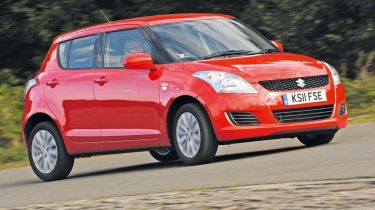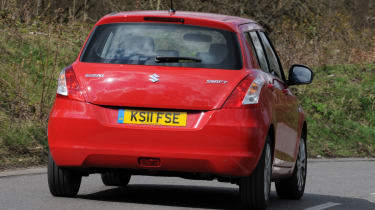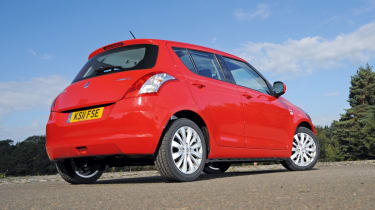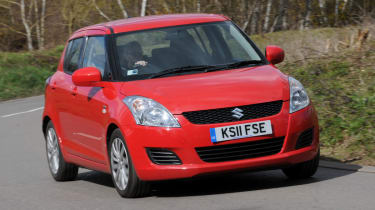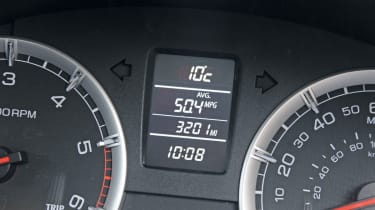Suzuki Swift (2010-2017) review
The Suzuki Swift is a fun-to-drive supermini with a lot of charm, but it’s not the most practical choice

The Suzuki Swift that you see before you is far away from the slab-sided tin box that the old Swift used to be when it landed in the UK in the eighties. This Swift was launched in 2010, and has proved to be one of Suzuki’s most popular models ever.
Although it’s one of the older cars in its class, it’s still an attractive choice thanks to its value for money. It has a host of rivals from many manufacturers, so goes toe-to-toe with cars like the Ford Fiesta, Vauxhall Corsa and Toyota Yaris. Other choices include the Volkswagen Polo, Mazda 2 and Nissan Micra.
The Swift is available as a three or five-door with a 1.2-litre petrol engine. Although there’s only one engine, you can have it with 93bhp or the more economical 89bhp Dualjet. The Dualjet also features start/stop tech to help boost that economy figure. There’s also the hotter Suzuki Swift Sport that we’ve reviewed separately, with a 134bhp naturally-aspirated 1.6-litre engine and a sharper chassis. Between 2011 and 2014 you could also get a 1.3-litre DDiS diesel.
Little has changed in the Swift’s range during its lifespan; the trim levels are SZ2, SZ3, SZ4 and Sport, while a mild facelift in 2013 kept things relatively fresh. On top of the trim levels, Suzuki offers a Swift 4x4. It’s designed to take on any inclement weather and links back to the brand’s long-standing reputation of making chunky 4x4s. However, the extra weight of the four-wheel drive transmission does harm fuel economy and performance.
Used - available now

2021 Suzuki
Swift
34,933 milesManualPetrol1.2L
Cash £9,900
2019 Suzuki
Swift
35,700 milesManualPetrol1.2L
Cash £8,806
2021 Suzuki
Swift
23,615 milesManualPetrol1.2L
Cash £11,787
2021 Suzuki
Swift
20,712 milesManualPetrol1.2L
Cash £11,383The 1.2-litre Dualjet petrol engine was introduced as an option for the Swift SZ4 in 2015. With its 99g/km CO2 emissions, this brought the prospect of free road tax. The 1.2 Dualjet engine has since become standard in the 4x4 model, boosting efficiency – it claims 58.8mpg fuel economy and CO2 emissions of 111g/km in this version. At the same time, Suzuki fitted electric rear windows to all five-door Swift models as standard, while top-spec SZ4 and Sport cars can now be had with sat-nav.
The Suzuki Swift is a fun small car that appeals on many levels. The low price, great handling and smart styling help to set it apart in the supermini market.
Whether you want a car to just pop to the shops in or to take on a twisty B-road, the Swift makes every journey fun, but a small boot and cramped rear seats mean it’s not the most practical choice in this class. Some buyers may also be put off by the bland interior, which can’t match more expensive rivals like the Volkswagen Polo.
Still, the top-of-the-range Swift Sport is a great ‘warm’ hatch, and although the performance isn’t blistering, it’s a brilliant little car to drive. In fact, push any Swift through a series of corners, and you’ll notice that it shares some of the Sport model’s DNA.
Engines, performance and drive
On the road, the Swift feels very nimble and is easy to drive, which makes town driving a doddle. Plus, on a twisting B-road, it’s almost as much fun as Ford Fiesta, thanks to its sharp steering, strong grip and slick gearchange.
This is particularly true of the Swift Sport. The range-topping model’s uprated chassis provides acrobatic agility in corners, even if the Sport isn’t a true hot hatch in the same vein as the similar-sized Ford Fiesta ST.
No matter which version of the Swift you go for, impressive motorway refinement is guaranteed, as is great ride composure, with the suspension soaking up most bumps and potholes.
The regular front-wheel-drive Swift has excellent driving dynamics, but the 4x4 version doesn’t compromise on the fun factor, either, while also providing plenty of extra reassurance in harsh weather. Just don’t expect to do any serious off-roading in this car – that’s not really what it’s designed for.
Engines
There are just two engines to choose from in the current Swift range. Most buyers will opt for the smaller 1.2-litre petrol engine, which is a smooth and eager performer, although it does need to be worked hard to give its best.
However, drivers wanting maximum thrills should take the Suzuki Swift Sport for a spin. Its combination of a 134bhp 1.6-litre engine and a precise six-speed manual gearbox means the 0-62mph sprint takes just 8.7 seconds, and the car feels eager throughout its rev range.
The slick manual gearbox in the regular Swift definitely works better than the automatic; although the auto gearbox option is smooth enough, it’s rather slow to respond. Meanwhile, the choice between two and four-wheel drive will make little difference to outright performance.
Unusually in the supermini class, Suzuki doesn’t offer the Swift with diesel power. There used to be a diesel model, which used a 74bhp 1.3-litre engine shared with the previous-generation Vauxhall Corsa, and it was decent fun to drive, providing a good burst of its 190Nm of torque from low in the rev band. But this was axed from the range in 2014, so petrol is now the only option.
MPG, CO2 and Running Costs
Whichever model you go for, the Suzuki Swift offers reasonably low running costs that compare fairly well with other superminis.
The entry-level 1.2-litre petrol claims 56.5mpg fuel economy, which is decent but not outstanding. Its 116g/km CO2 emissions figure (the same for the three or five-door) is also a bit disappointing compared to newer rivals such as the Ford Fiesta 1.0-litre EcoBoost. Opt for the four-speed automatic Swift, and these figures look even less impressive: it claims 50.4mpg and 128g/km.
If you’re obsessed about running costs, a new Dualjet version of the 1.2-litre engine is the most frugal option in the range. Its revised engine internals reduce friction and boost efficiency. Power output is slightly down (89bhp versus 93bhp), but it delivers slightly more torque (120Nm versus 118Nm).
The Swift Dualjet also benefits from modified gear ratios and engine stop/start as standard, and the official figures show how these tweaks have paid off: it claims 65.7mpg economy and 99g/km emissions.
But while that means fewer fuel stops and zero road tax, Suzuki predicts you’ll only save around £150 over a typical year over the standard 1.2. Since the Dualjet model costs £500 more, it’ll take over three years before you’ve even broken even on your investment.
For comparison, the 1.3-litre diesel claimed 72.4mpg economy before it was discontinued, although disappointingly it didn’t dip under the 100g/km CO2 threshold.
Insurance groups
One good thing about the Swift is that it’s pretty cheap to insure. Nearly every model is classed as group 11E, which compares well with rivals like the Ford Fiesta. The exception is the Swift Sport, which sits in group 19E – although that’s quite typical of racy models like this.
Depreciation
The Swift is keenly priced new, and remains popular among used car buyers, so it holds on to its value fairly well – if not quite as well as more ‘premium’ rivals like the Volkswagen Polo.
Interior, design and technology
The Suzuki Swift’s styling is certainly distinctive and handsome, although it doesn’t look quite as charismatic as the MINI. Its high-roof shape is unique among superminis, and the Swift is attractive for a car that competes at the cheaper end of the market.
The interior is well designed, too, although the plastics feel built down to a price and look a bit bland.
There are three main trim levels: SZ2, SZ3 and SZ4. All cars come with remote locking, split-folding rear seats and electric front windows (plus electric rear windows in five-door cars). You also get heated door mirrors, as well as a CD tuner with USB port and audio controls on the steering wheel.
Our pick of the range is the SZ3, which comes with manual air-conditioning, front foglamps, Bluetooth phone connectivity and 16-inch alloy wheels.
Range-topping SZ4 cars also get luxuries like automatic air-con, sat-nav and automatic headlights, as well as keyless entry and start. Rear parking sensors are a useful optional extra.
Special Edition SZ-L models have two-tone paintwork and silver stitching on the steering wheel and gearlever, plus unique fabric for the seats. It’s not a subtle look, but if you’re over 25, the SZ-L isn’t really aimed at you.
The Suzuki Swift Sport is the performance model in the range – although it’s more warm hatch than hot hatch – and is identified by its racy bodykit, 17-inch alloys, twin-exit exhaust and bright HID headlamps.
The Swift 4x4 comes in SZ3 or SZ4 trim only, with the latter getting front and rear bash plates and plastic wheelarch protectors, which provide an extra dose of style.
Sat-nav, stereo and infotainment
As you’d expect, basic Swift models have a fairly simple audio system, but it still includes an MP3-compatible CD tuner, steering wheel-mounted audio controls and a USB socket. The SZ3 adds Bluetooth connectivity with voice-activated music streaming capability.
The navigation, entertainment and communication system standard on the Swift SZ4 (and optional on other models) works very well. Key features include a DAB radio, European mapping (with coverage of 45 countries), Bluetooth hands-free phone connectivity and a 6.1-inch colour touchscreen.
Practicality, comfort and boot space
This is a very compact car by class standards, so it’s a doddle to handle around town. Visibility is great, too, with what seems like a wall of glass wrapped around the car, making parking a piece of cake.
However, that small size does impact on room inside. The Swift is far behind its rivals when it comes to interior space, both for passengers and luggage. The seats are comfortably padded and offer good support when cornering, but overall you’ll be more comfortable in rivals like the Volkswagen Polo and Citroen C3.
Size
At 3,850mm long, the current Swift is about 90mm longer than the previous generation, although it’s still smaller than most superminis. For instance, the Ford Fiesta measures 3,969mm long and 1,709mm wide – larger than the Suzuki in both respects. While that makes the Swift easier to manoeuvre and park, it’s tighter on room inside.
Leg room, head room & passenger space
Although there’s a plenty of space up front, rear passengers won’t feel so comfortable. There’s significantly less head and legroom than you’ll find in a Volkswagen Polo or Renault Clio. At least the interior offers a decent amount of useful storage, including a deep centre console cubby, large glovebox and big door bins.
Boot
With a boot capacity of just 211 litres, the Swift is beaten by the likes of the Vauxhall Corsa and Honda Jazz – and even the Skoda Citigo from the class below has a bigger load bay.
The boot is a bit of an odd shape, too, and the available space is mostly vertical – so wide items are a struggle to fit in. Plus, with the rear seats folded, there’s an annoying step in the floor that can prove intrusive when you’re carrying larger items.
Fold the rear seats, and the three-door Swift provides a maximum load capacity of 892 litres, while the five-door manages 902 litres – both quite a lot less than a Ford Fiesta (which can swallow 974 litres).
Reliability and Safety
The Suzuki Swift has strong safety credentials. When Euro NCAP crash tested the car n 2010, it awarded it a full five-star rating, with a very impressive 94 per cent score for adult occupant protection. However, the 2010 test wasn't as tough as the latest regime, so you can't compare the Swift's score to newer rivals.
Standard safety equipment is generous, with a total of seven airbags. These include a driver’s knee airbag, which is an unusual feature for the supermini class. All models also feature ESP (stability control), ABS, front passenger airbag deactivation and seatbelt reminders. Plus, you can happily install child seats using either Isofix mountings or the car’s seatbelts.
Impressive as this is, though, the Swift shows its age with its lack of advanced safety kit. Features like city braking, blind spot indicators and lane departure warning – now available on a number of rivals – aren’t even offered as options.
The Suzuki wasn’t rated very highly by owners in the Auto Express Driver Power 2015 satisfaction survey. It ranked in 130th place for reliability – well down on rivals like the Toyota Yaris (which finished in 26th position in this category), MINI (40th) and Mazda 2 (58th). That means the Swift could well disappoint when it comes to long-term ownership.
Our Driver Power 2015 survey also highlighted owners’ concerns about build quality. While the Hungarian-made Suzuki appears solidly put together on the surface, drivers tell us this impression doesn’t last, and the car was ranked only 187th out of 200 cars for build quality in the 2015 chart. That means you need to beware if you’re considering a used Swift.
Warranty
Every Suzuki comes with a three-year, 60,000-mile warranty, which is the norm for this class. However, some rivals do offer more generous warranties these days; for instance, the Toyota Yaris and Hyundai i20 both have five-year warranties, while the Kia Rio comes with a seven-year warranty.
Servicing
Although the Swift has shorter service intervals than many rivals –maintenance is required every 9,000 miles – this is offset by the relatively low cost of dealer servicing. Suzuki offers a range of pre-paid plans, which allow you to spread the cost of servicing and fix prices at current levels.
